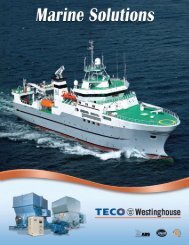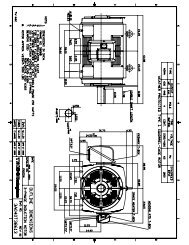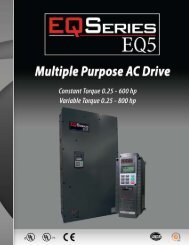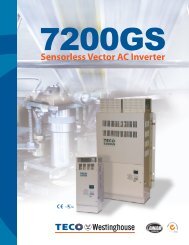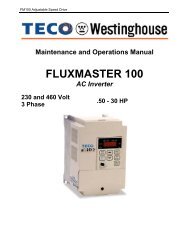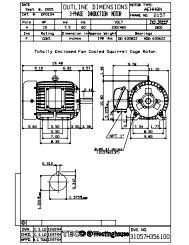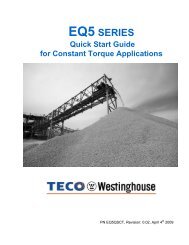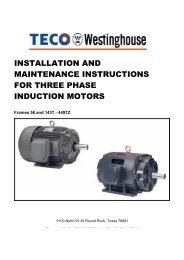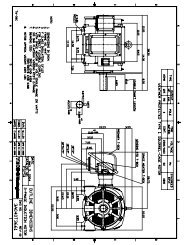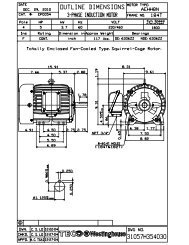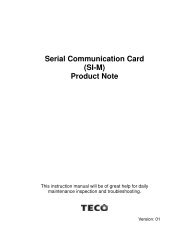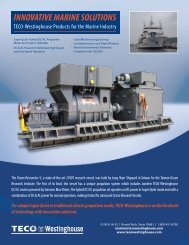EQ7 Series Instruction Manual - TECO-Westinghouse Motor Company
EQ7 Series Instruction Manual - TECO-Westinghouse Motor Company
EQ7 Series Instruction Manual - TECO-Westinghouse Motor Company
You also want an ePaper? Increase the reach of your titles
YUMPU automatically turns print PDFs into web optimized ePapers that Google loves.
*1 Install a recommended molded case circuit breaker (MCCB) or residual-current-operated protective device<br />
(RCD)/earth leakage circuit breaker (ELCB) (with overcurrent protection function) in the primary circuit of the<br />
inverter to protect wiring. Ensure that the circuit breaker capacity is equivalent to or lower than the recommended<br />
capacity.<br />
*2 Install a magnetic contactor (MC) for each inverter to separate the inverter from the power supply, apart from the<br />
MCCB or RCD/ELCB, when necessary.<br />
Connect a surge absorber in parallel when installing a coil such as the MC or solenoid near the inverter.<br />
*3 The R0 and T0 terminals are provided for inverters with a capacity of 2 HP or above.<br />
To retain an alarm output signal ALM issued on inverter's programmable output terminals by the protective function<br />
or to keep the keypad alive even if the main power has shut down, connect these terminals to the power supply<br />
lines. Without power supply to these terminals, the inverter can run.<br />
*4 Normally no need to be connected. Use these terminals when the inverter is equipped with a high power-factor,<br />
regenerative PWM converter (RHC series).<br />
*5 When connecting an optional DC reactor (DCR), remove the jumper bar from the terminals P1 and P(+).<br />
<strong>EQ7</strong>-2100-C/<strong>EQ7</strong>-4100-C and larger HP models require a DCR (packed with the <strong>EQ7</strong>) to be connected.<br />
Use a DCR when the capacity of the power supply transformer exceeds 500 kVA and is 10 times or more the<br />
inverter rated capacity, or when there are thyristor-driven loads in the same power supply line.<br />
*6 <strong>EQ7</strong>-2015-C/<strong>EQ7</strong>-4015-C and smaller have a built-in braking resistor (DBR) between the terminals P(+) and DB.<br />
When connecting an external braking resistor (DBR), be sure to disconnect the built-in one.<br />
*7 A grounding terminal for a motor. Use this terminal if needed.<br />
*8 For control signal wires, use twisted or shielded-twisted wires. When using shielded-twisted wires, connect the<br />
shield of them to the common terminals of the control circuit. To prevent malfunction due to noise, keep the control<br />
circuit wiring away from the main circuit wiring as far as possible (recommended: 10 cm/3.9 inches or more). Never<br />
install them in the same wire duct. When crossing the control circuit wiring with the main circuit wiring, set them at<br />
right angles.<br />
*9 The connection diagram shows factory default functions assigned to digital input terminals [X1] to [X7], [FWD] and<br />
[REV], transistor output terminals [Y1] to [Y4], and relay contact output terminals [Y5A/C] and [30A/B/C].<br />
*10 Switching connectors in the main circuits. For details, refer to "<strong>Instruction</strong> manual section 2.3.4 Switching<br />
connectors" later in this section.<br />
*11 Slide switches on the control printed circuit board (control PCB). Use these switches to customize the inverter<br />
operations. For details, refer to Section 2.3.6 "Setting up the slide switches."<br />
*12 When the Enable input function is not to be used, keep terminals [EN1]-[PLC] and terminals [EN2]-[PLC]<br />
short-circuited using jumper wires. For opening and closing the hardware circuit between terminals [EN1] and [PLC]<br />
and between [EN2] and [PLC], use safety components such as safety relays and safety switches that comply with<br />
EN954-1 or EN ISO13849-1 Category 3 or higher.<br />
*13 To bring the inverter into compliance with the European Standard, Low Voltage Directive EN61800-5-1, be sure to<br />
insert the specified fuse in the primary circuit of the inverter.<br />
Primary grounding terminal ( G) for inverter enclosure<br />
Two grounding terminals ( G) are not exclusive to the power supply wiring (primary circuit) or motor wiring (secondary<br />
circuit). Be sure to ground either of the two grounding terminals for safety and noise reduction. The inverter is designed<br />
for use with safety grounding to avoid electric shock, fire and other disasters.<br />
The grounding terminal for inverter enclosure should be grounded as follows:<br />
1) Ground the inverter in compliance with the national or local electric code.<br />
2) Use a thick grounding wire with a large surface area and keep the wiring length as short as possible.<br />
Inverter output terminals U, V, and W and secondary grounding terminals ( G) for motor<br />
Inverter’s output terminals should be connected as follows:<br />
1) Connect the three wires of the 3-phase motor to terminals U, V, and W, aligning the phases each other.<br />
2) Connect the secondary grounding wire to the grounding terminal ( G).<br />
When there is more than one combination of an inverter and motor, do not use a multi-conductor cable for the<br />
purpose of running the leads together.<br />
2-12



